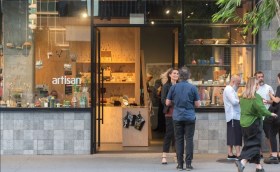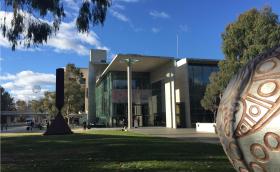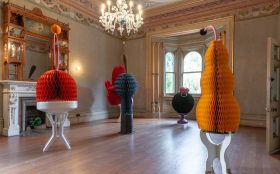Senior curator David Hurlston inside Roger Kemp: Visionary Modernist at The Ian Potter Centre: NGV Australia. Photo: Eugene Hyland.
The Western cannon has a long history of representing the spiritual in art: iconography drawing from Christian symbolism conveyed the religious experience, making the transcendental physical. A product of this tradition, the Australian Modernist artist Roger Kemp explored notions of the metaphysical by infusing his passion for music through line and colour with his personal symbolism of geometric forms such as the circle, square and cross to form a language beyond words.
‘What is possible for a composer to get out of an octave, I can get out of these units, these symbols of mine,’ said Kemp.
Influenced by Cubists such as Paul Cezanne, Kemp challenged the accepted paradigms of the day by interrogating his forms through angular mark-making and flattening of the picture plane to become one of Australia’s leading abstract artists.
Developed in close association with the artist’s estate, the exhibition Roger Kemp: Visionary Modernist, at NGV Australia in Federation Square, comprises paintings, prints and sketches. This exhibition is the most comprehensive retrospective of the artist’s work since his death in 1987 and features some never before publicly exhibited works.
Despite exhibiting in more than 20 solo exhibitions over his artistic life time and being the recipient of many awards, Roger Kemp remains relatively unknown in the public consciousness. He’s perhaps best known for the large tapestries of his works hanging in the Great Hall at the NGV International, just below the stained-glass ceiling by Leonard French whom he inspired. This finely curated exhibition is unassuming, a bit like the man himself, despite the power and scale of his art.
Segueing through spaces in a gallery on the third floor, the exhibition caters well for a range of physical abilities with gallery access via stairs or lift with restrooms close at hand. Interpretive material such as didactic panels take the viewer through the artist’s development over a 50-year period, from his symbolic early landscapes and angular figures of the 1930s, to his fusion of the abstracted human form into a more overtly geometric framework during the 1950s and 1960s, to his later, larger, more mystical explorations with their atomic-like forms jostling, vying for space, like the building blocks of creation.
Text labels also accompany the works however the groupings for some of these in relation to the paintings can be a little confusing. Display cabinets with examples of his etchings utilising the geometric framework of his painting reflect powerful, confident mark-making while sketches and photographs in separate cabinets support his art, giving an insight into the evolution of Kemp’s ideas as well as the artistic milieu of the times. In a small room located off one of the main spaces, a 1975 television documentary co-production 10 Australian Artists by the ABC and Visual Arts Board provides further insight into this enigmatic artist and his intuitive method of artmaking.
An early abstracted oil-on-board landscape painting, Music in Nature (1936), celebrates the spirit of nature and the joy of music through gestural mark-making and vibrant colour. Later, works such as Flight in space 1 (1961-c.1965) and Piano movement (1960 – 62), both enamel paint on composition board, exude an energy, their rhythmic forms and colours now caught in a geometric grid with a limited tonal palette. The black outlined framework, like the lead of stained-glass, frames fragments of colour and explores ideas beyond the verbal. This was to become his signature form of representation for the remainder of his artistic career.
Building on this notion of the spiritual, the exhibition climaxes with a darkened gallery space. Low lighting and walls painted black take the viewer into a quieter space, connecting with the black framework of the paintings that seem to hover just beyond the wall surface; Configuration (1981, oil and enamel paint on canvas) vibrates with rapid, loose brush strokes. An example of his return to strong vibrant colours, it consists of loosely formed circles and crosses which, like paintings that surround it, demand the viewer’s attention. A fitting culmination for an artist whose creative oeuvre represents a lifelong journey in making the intangible tangible. Seating for contemplation and catalogues for further reference are also provided.
4 stars out of 5 ★★★★
Roger Kemp: Visionary Modernist
22 August 2019 – 15 March 2020
The Ian Potter Centre: NGV Australia – Federation Square, Melbourne VIC
Free admission






